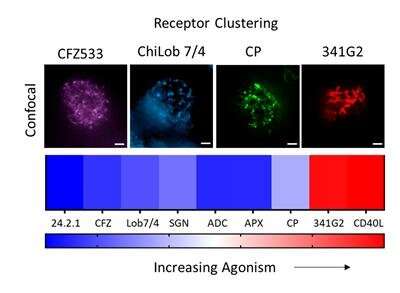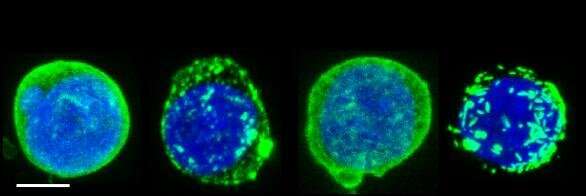Credit: University of Southampton
Scientists from within the Antibody and Vaccine Group at the University of Southampton have gained novel insights into how an important class of immune receptors called tumor necrosis factor receptors (TNFR) are activated.
The work, published in the journal Communications Biology, investigates a class of receptors present on immune cells called TNFR. These receptors, such as CD40, 4-1BB and OX40, are key in helping the immune system fight pathogens and cancer cells. Accordingly, antibody drugs which are designed to specifically target and activate these receptors (called agonists) have been developed for cancer treatment.
The mechanism by which these receptors are activated on the cell surface is important for designing optimal drug formats; however, to date it is not fully understood. Previous work showed that receptor clustering, redistribution of receptors dispersed over the cell surface into localized clusters, is essential for TNF receptor activation, and it is commonly believed that larger clusters induce more potent activation.
The current study, led by Dr. Ben Yu and Professor Mark Cragg at the Centre for Cancer Immunology, with colleagues across the University and at ONI UK, employed a set of unique reagents developed at Southampton targeting CD40, 4-1BB and OX40, as well as a new super-resolution microscopy acquired through funding from from the Mark Benevolent Fund, to address how differential receptor clustering mediates receptor activity.
CD40 receptor clustering driven by CD40 ligand or anti-CD40 antibody, 341G2 with the human IgG2 (h2) isotype. Jurkat cells expressing full length hCD40-green fluorescent protein (GFP), were treated with 10 μg/mL of different CD40 agonists as indicated for 1 hour and the nucleus stained with DAPI (blue) and imaged using a confocal microscope. All images are representative of at least 10 images from at least 2 independent experiments. Scale bar, 4 μm. Credit: University of Southampton
Results from the study confirmed that TNF receptor activation absolutely requires receptor clustering but interestingly, disproved the commonly held belief that larger clusters induce more receptor activation. Rather, the study finds that agonists that induced smaller clusters—but with higher receptor density—mediated better TNF receptor activity than those which induced larger clusters.
In addition to receptor size, the study reveals that one of the most potent antibody agonists targeting CD40 induced a novel rod-shaped clustering structure, which could potentially explain the super-agonistic nature of that antibody. These findings add significant insight into how TNF receptors cluster to mediate immune activation and will help guide future development of therapeutic antibodies targeting TNF receptors.
More information: Xiaojie Yu et al, TNF receptor agonists induce distinct receptor clusters to mediate differential agonistic activity, Communications Biology (2021). DOI: 10.1038/s42003-021-02309-5
Journal information: Communications Biology
Provided by University of Southampton

























